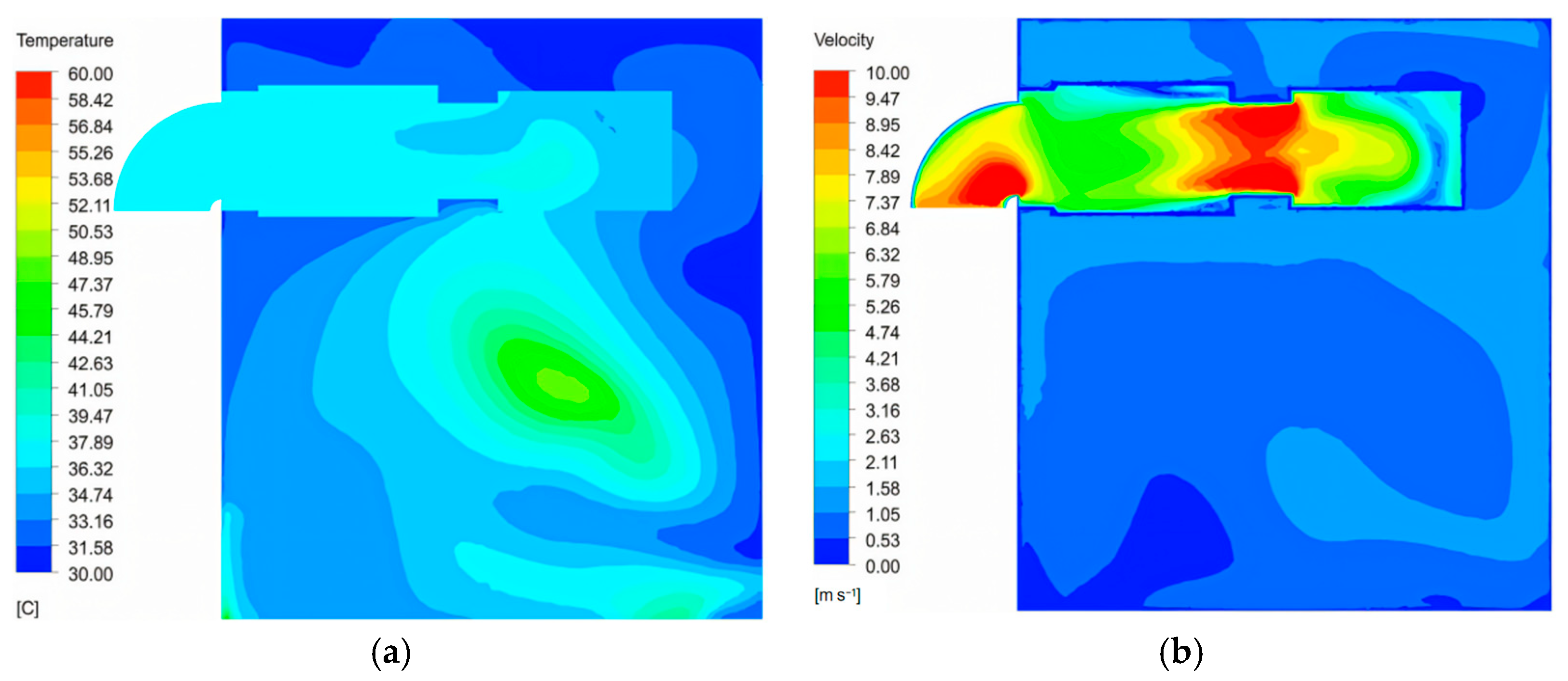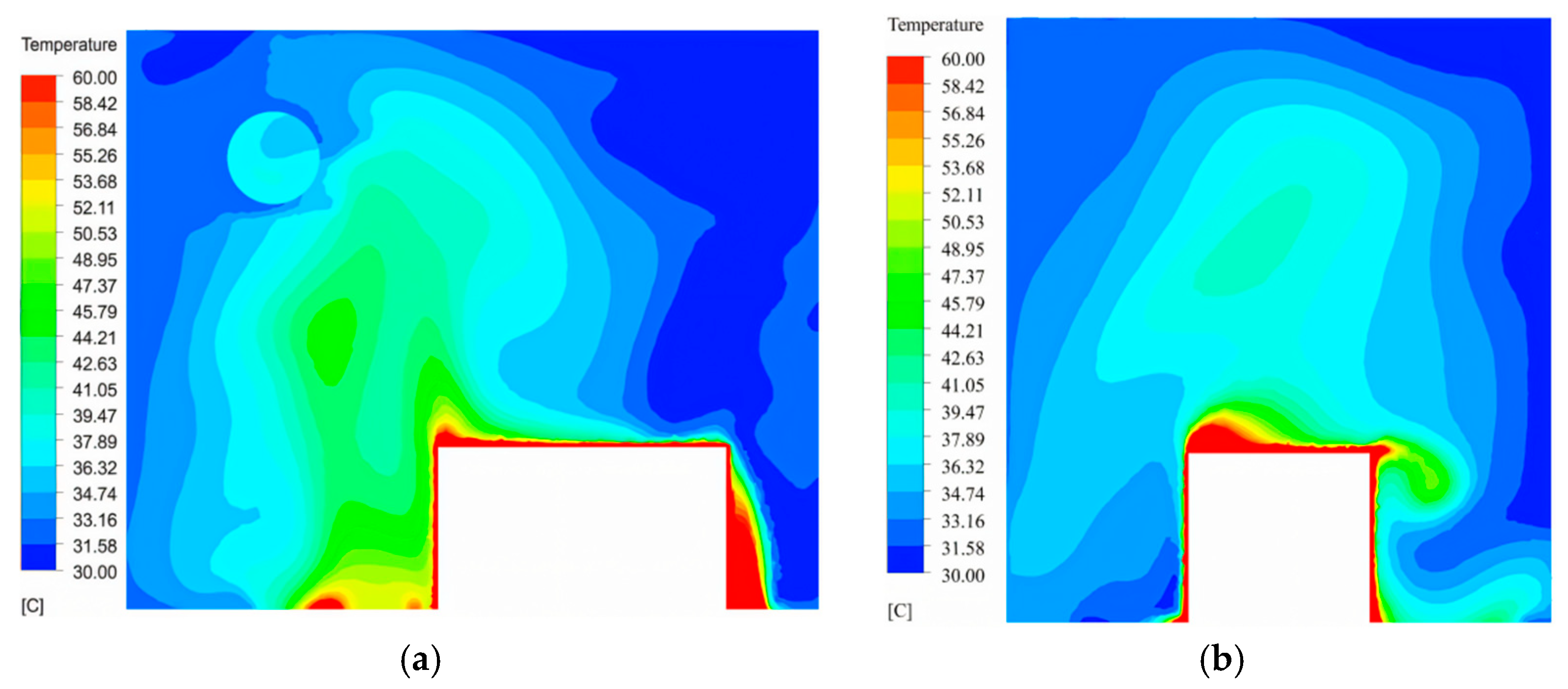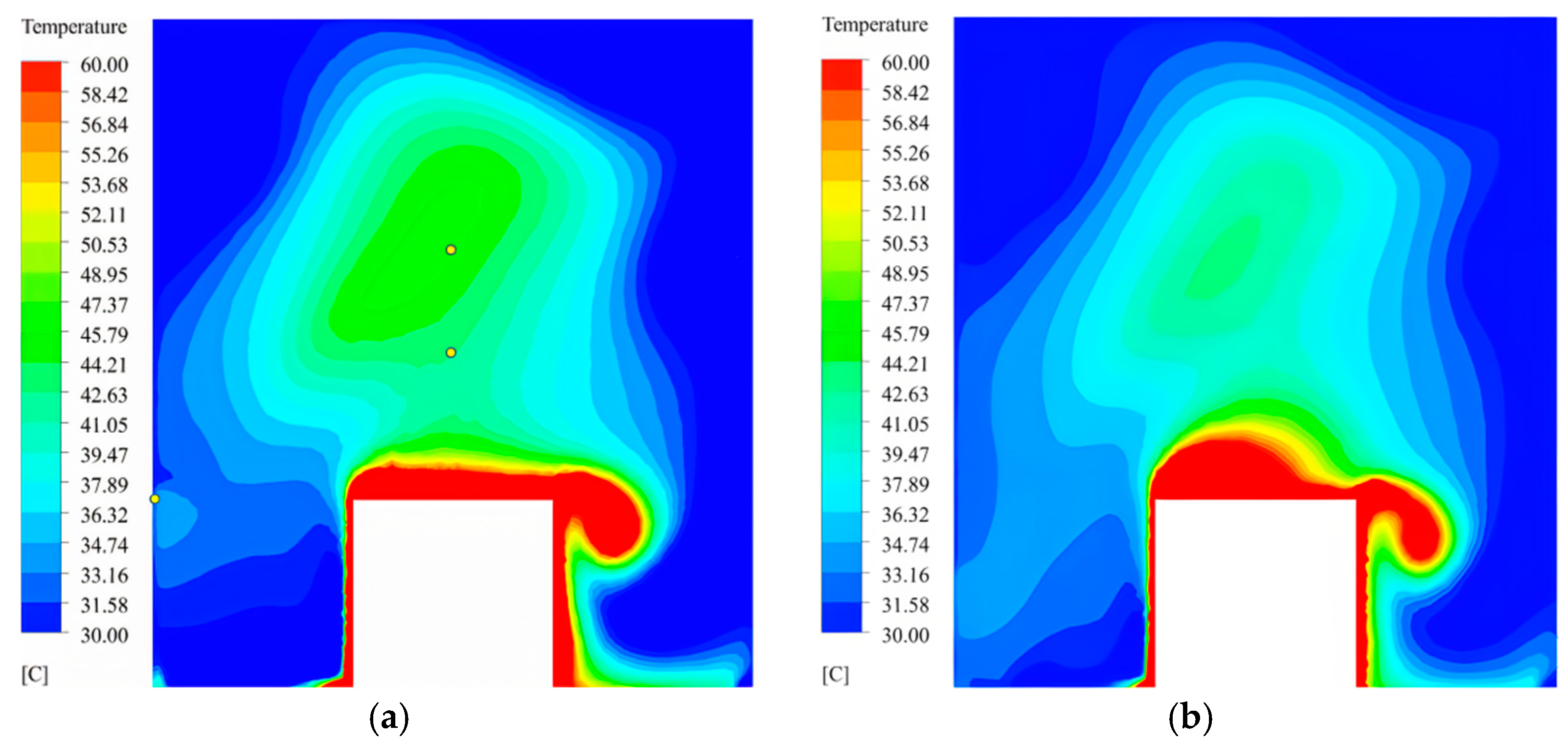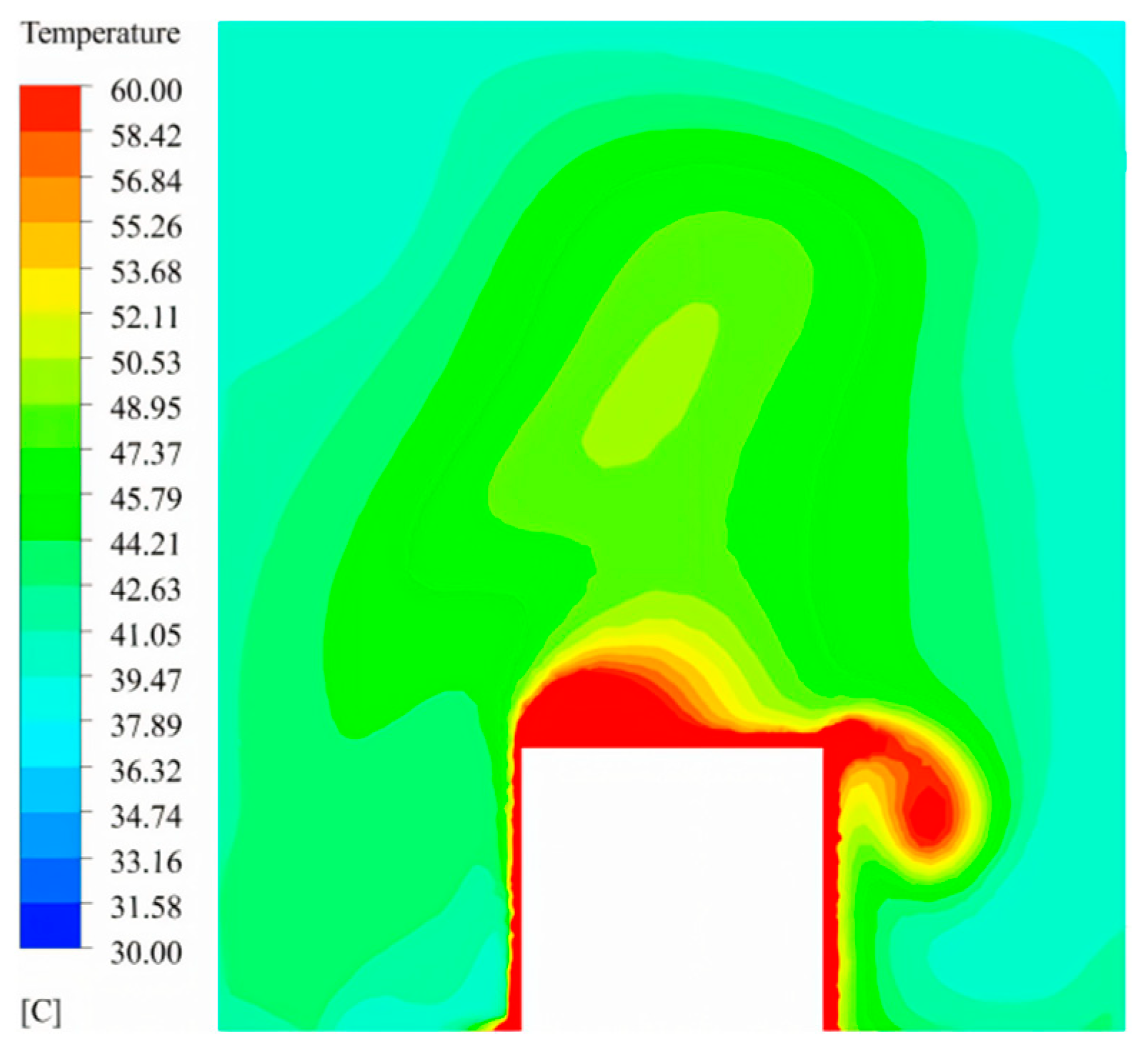An Investigation of the Ventilation Systems of Whole-Indoor Urban Substations
Abstract
1. Introduction
2. The Theoretical Models
2.1. The Mathematical Models
2.2. The Physical Models
2.3. The Boundary Conditions
- (1)
- The south wall and the roof of the room are in contact with the external environment, while the remaining three walls are adjacent to other rooms. Consequently, heat transfer through these three walls to the outside is not considered. Therefore, only the south wall and the roof are set as the convection heat transfer boundary conditions, with a convection heat transfer coefficient of 1.85 W/(m2·K) [22]. Other walls are set to adiabatic conditions (no sliding solid wall constant temperature boundary condition).
- (2)
- For natural ventilation, electrically adjustable shutters are set to speed inlet and pressure outlet boundary conditions.
- (3)
- For natural air inlet combined with mechanical exhaust, the electric regulation shutter and fan outlet are set to the speed inlet boundary condition; the inlet speed is positive, and the outlet speed is negative (indicating that the airflows to the outside). The inlet wind speed and temperature are based on meteorological parameters from Dezhou, Shandong Province. Additionally, the mechanical exhaust speed is determined using the exhaust air volume.
- (4)
- The wall of the air duct is set as the adiabatic boundary, and the fan inlet is located inside the fluid area, so it is set as the internal boundary condition (interior).
- (5)
- The wall of the heat dissipation equipment is set as the constant heat flux boundary, and the heat flux value is calculated according to the heat dissipation capacity of the equipment.
- (6)
- The thermal physical properties of air are set as constant, the density is 1225 kg/m3, the specific heat is 1006.43 J/(kg·K), the thermal conductivity is 0.0242 W/(m·K), and the viscosity is 1.7894 × 10−5 kg/(m·s).
3. The Simulation Result
4. The Experimental Research
4.1. The Construction of the Experimental Platform
4.2. Setting of Working Conditions
4.3. The Experimental Tests
4.3.1. The Wind Speed Measurement
4.3.2. Working Condition Tests
4.3.3. Comparison Between Experiment and Simulation
5. The Noise Test
6. The Simulation Analysis
6.1. Influence of Different Ventilation Volumes on Indoor Temperature
6.2. Influence of Different Heat Dissipation on Indoor Temperature
6.3. Influence of Different Outdoor Temperatures on Indoor Temperatures
6.4. Indoor Temperature Distribution Under Extreme Maximum Temperatures in Winter and Summer
7. Conclusions
- (1)
- A hybrid ventilation system combining natural and mechanical ventilation was proposed. When the indoor temperature is below 30 °C, heat dissipation occurs solely through the enclosure structure. When the indoor temperature reaches 35 °C, the natural air inlet mechanical exhaust mode is used.
- (2)
- The mathematical and physical model of the entire indoor substation’s ventilation system was established, with relevant conditions set for simulation and analysis. The results indicate that the system effectively maintains the indoor temperature within 40 °C.
- (3)
- An experimental platform of the ventilation system combining natural ventilation and mechanical ventilation was established, and a T35 axial fan with a flow rate of 23,624 m3/h was selected using experimental tests. At the same time, the system was verified in experiments and compared with the simulation results, and the feasibility of the ventilation system was verified in experiments.
- (4)
- The noise of the experimental platform was studied, and noise reduction measures such as eggshell cotton and silent rock wool were arranged. The noise values of outdoor 5 m and 10 m were 66 dB and 62 dB, respectively, during actual measurement, and the accuracy of the noise values was determined using measurement and prediction.
- (5)
- The influence of the outdoor temperature, ventilation volume, heat dissipation, and other factors on the indoor temperature of the indoor substation was simulated. The results indicate that when other factors remain unchanged, the lower the outdoor temperature, the larger the ventilation volume, the smaller the heat dissipation capacity, and the lower the indoor temperature. The smaller the difference between the outdoor temperature and indoor temperature, the smaller the influence on the indoor temperature. In addition, energy savings should also be taken into account during ventilation and cooling. According to the simulation results obtained in this study, the calculated ventilation volume is more reasonable.
- (6)
- The indoor temperature distribution under winter and extreme maximum temperature in summer was obtained via simulation. In winter, only natural ventilation can meet the indoor temperature requirements, so the system can choose the appropriate ventilation mode under different working conditions, thereby saving energy. Under extreme maximum-temperature weather in summer, the ventilation volume calculated at the outdoor temperature of 30.6 °C was simulated. The indoor temperature was basically 47.37 °C, and the highest was 53.68 °C.
Author Contributions
Funding
Data Availability Statement
Conflicts of Interest
Nomenclature
| t | time of gas flow throughout the house (s) |
| u, v, w | the velocity component of the fluid in the x, y, and z directions (m/s) |
| ρ | indoor gas density (g/m3) |
| the stress component of the fluid at (i, j) (Pa) | |
| p | fluid pressure (N) |
| ,, | the volume force of a microelement (°C) |
| T | indoor gas temperature (°C) |
| K | heat transfer coefficient (W/(m2·K)) |
| newly defines a source term associated with a user-defined volume heat | |
| L | amount of ventilation required for heat removal (m3/h) |
| Q | the reactor dissipates heat (W) |
| c | specific heat capacity of air (KJ/(kg·℃)) |
| ρav | kg/m3) |
| tin, tex | inlet and exhaust air temperature (°C) |
| L | air volume of tuyere (m3/h) |
| v | tuyere velocity (m/s) |
| F | tuyere area (m2) |
| Greek | |
| ρ | density (kg/m3) |
| τ | time (s) |
| Subscripts | |
| x, y, z | serial number along the rectangular coordinate system |
| i, j | the serial number of the node along radial and vertical directions |
| av | average |
| in, ex | inlet air, exhaust air |
References
- Ding, B.; Liu, J.; Jia, Y. Research and simulation on building energy use of indoor substation. Build. Energy Effic. 2021, 49, 85–90. [Google Scholar] [CrossRef]
- Cheng, Z. A Brief discussion on building energy saving and noise reduction design of urban all-household substation. Low Carbon World 2016, 10, 35–36. [Google Scholar] [CrossRef]
- Xu, H. Thoughts on heat dissipation and ventilation of main transformer room in indoor substation. Sci. Technol. Wind. 2011, 12, 197. [Google Scholar] [CrossRef]
- Zhang, F.; Huang, X.; Ding, J. Numerical Simulation and Optimization Analysis of Ventilation Heat Transfer in Indoor Substation. Fluid Mach. 2016, 44, 76–80. [Google Scholar] [CrossRef]
- Zhang, R. Architectural Design Research of Urban Indoor Substation. Master’s Thesis, Beijing University of Civil Engineering and Architecture, Beijing, China, 2017. CNKI:CDMD:2.1018.041811. [Google Scholar]
- Zhang, H.; Wang, L. Optimizing air inlet design for enhanced natural ventilation in indoor substations: A numerical and CFD simulation study. Case Stud. Therm. Eng. 2024, 59, 104408. [Google Scholar] [CrossRef]
- Mo, W.; Zeng, W. Analysis and Countermeasures of Ventilation and Heat dissipation of indoor substation Main transformer. Guangdong Power Transm. Transform. Technol. 2004, 5, 27–31. [Google Scholar] [CrossRef]
- Hong, W.; Jia, L. Improvement of ventilation design of 110kV whole-household urban substation. J. Distrib. Util. 2009, 26, 46–48. [Google Scholar] [CrossRef]
- Chen, C. Research on improvement of ventilation noise reduction technology in old indoor substation. Environ. Sci. Technol. 2022, 28, 44–49. [Google Scholar] [CrossRef]
- Dong, Q.; Wei, Y.; Guo, L. Noise control analysis of 330kV/110kV co-built indoor substation. Sichuan Environ. 2022, 9, 206–211. [Google Scholar] [CrossRef]
- Gao, X.; Li, W.; Song, H.; Zhang, S. Influence of Air Inlet on Ventilation effect of transformer chamber. Civ. Archit. Environ. Eng. 2012, 34, 117–122. [Google Scholar]
- Xing, H. Numerical Simulation of Ventilation and Heat Transfer in Indoor Substation and Its Countermeasures. Master’s Thesis, Chongqing University of Technology, Chongqing, China, 2013. [Google Scholar] [CrossRef]
- Qin, W.; Huang, Y.; Xia, Z. Measurement and simulation of ventilation and cooling in main transformer room of 110 kV indoor substation. Energy Res. Util. 2018, 1, 31–34. [Google Scholar] [CrossRef]
- Jin, J.; Wei, L.; Po, H.; Guo, Z.; Wen, B.; Jiang, N. Simulation and Optimization of ventilation and noise reduction in indoor substation. J. Wuhan Univ. 2015, 48, 495–501. (In Chinese) [Google Scholar] [CrossRef]
- Mohamad, K.; Khaled, C. CFD study of ventilation for indoor multi-zone transformer substation. Int. J. Heat Technol. 2018, 36, 88–94. [Google Scholar] [CrossRef]
- Saipul, A.F.B.; Hasril, H. Flow and Heat Dissipation Analysis in Transformer Substation with Minimal Ventilation using CFD. Int. J. Eng. Technol. 2018, 7, 327–332. [Google Scholar] [CrossRef]
- Hasini, H.; Shuaib, N.H.; Yogendran, S.B.; Toh, K.B. Flow and heat distribution analysis of different transformer sub-stations. In Proceedings of the 2nd International Conference on Mechanical Engineering Research (ICMER 2013), Kuantan, Malaysia, 1–4 July 2013. IOP Conference Series: Materials Science and Engineering. [Google Scholar] [CrossRef]
- Wu, J. Study on the Influence of Building Openings on Indoor Natural Ventilation in Office Buildings. Master’s Thesis, Nanjing Normal University, Nanjing, China, 2014. [Google Scholar] [CrossRef]
- Wang, J.; Zhang, F.; Xing, H. Indoor substation based on CFD ventilation heat transfer numerical simulation and optimization design. J. Mech. Des. Manuf. 2016, 3, 45–47. [Google Scholar] [CrossRef]
- Han, Z.; Wang, J.; Lan, X. Fluent: Examples and Applications of Fluid Engineering Simulation; Beijing Institute of Technology Press: Beijing, China, 2004. [Google Scholar]
- GB50736-2012; Code for Design of Heating, Ventilation and Air Conditioning for Civil Buildings. National Standards of the People’s Republic of China: Shenzhen, China, 2012.
- Qin, W. Numerical Simulation and Optimization of Ventilation and Heat Dissipation in 110 kV Indoor Substation. Master’s Thesis, Southeast University, Nanjing, China, 2019. [Google Scholar] [CrossRef]
- GB 50229-2019; Design Manual for Heating, Ventilation and Air Conditioning in Thermal Power Plants and Substations. National Standards of the People’s Republic of China: Shenzhen, China, 2019.
- Cui, X.; Xie, L.; Li, L. Substation noise prediction based on SoundPLAN. Shandong Electr. Power Technol. 2022, 49, 64–69. [Google Scholar] [CrossRef]
- Xie, D.; Yang, Z.; Zeng, X. The wind farm based on SoundPLAN noise simulation analysis and optimization. J. Audio. Technol. 2023, 47, 32–34. [Google Scholar] [CrossRef]
- Liu, J. Discussion on the application of SoundPLAN in a substation noise influence and its control measures. Environ. Dev. 2018, 30, 113. [Google Scholar] [CrossRef]
- Liao, Q. Research on Noise Characteristics and Control Measures of UHV Substation. Master’s Thesis, Lanzhou Jiaotong University, Lanzhou, China, 2016. [Google Scholar] [CrossRef]
- Tang, J.; Wu, F.; Zhi, Y. Optimization design of ventilation noise reduction in Indoor Substation based on deep reinforcement Learning. Power China 2023, 56, 96–105. [Google Scholar] [CrossRef]
- Xu, T.; Wang, Y.; Zhang, Y. Numerical Simulation and Optimization of Air Intake in transformer room of a Substation. Electr. Power Sci. Eng. 2019, 35, 37–43. [Google Scholar] [CrossRef]
- Yuan, L.; Yu, J.; Kang, Y. Sensitivity analysis of thermal insulation performance of external walls and Windows in indoor thermal environment of natural ventilation buildings. J. Donghua Univ. 2019, 46, 128–133. [Google Scholar] [CrossRef]




















| Working Condition | Heat Dissipation Capacity (kW) | Inlet Air Temperature (°C) | Ventilation Volume (m3/h) |
|---|---|---|---|
| 1 | 20 | 21 | 3222.87 |
| 2 | 20 | 24 | 3846.84 |
| 3 | 20 | 27 | 4759.06 |
| 4 | 20 | 31 | 6909.88 |
| 5 | 30 | 21 | 4834.31 |
| 6 | 30 | 24 | 5770.26 |
| 7 | 30 | 27 | 7138.59 |
| 8 | 30 | 31 | 10,364.82 |
| 9 | 40 | 21 | 6445.74 |
| 10 | 40 | 24 | 7693.67 |
| 11 | 40 | 27 | 9518.12 |
| 12 | 40 | 31 | 13,819.75 |
| 13 | 50 | 21 | 8057.18 |
| 14 | 50 | 24 | 9617.09 |
| 15 | 50 | 27 | 11,897.65 |
| 16 | 50 | 31 | 17,274.69 |
| Physical Drawing | Item | Argument |
|---|---|---|
 | Measuring range | 0.3~45 m/s |
| Measuring accuracy | ±3% ± 0.1 dgt | |
| resolution | 0.1 m/s | |
| Temperature measurement range | 0~45 °C | |
| Temperature measurement error | ±2 °C |
| Measurement | Air Inlet 1 Wind Speed (m/s) | Air Inlet 2 Wind Speed (m/s) | Air Inlet 3 Wind Speed (m/s) | Fan Inlet Wind Speed (m/s) |
|---|---|---|---|---|
| 1 | 2.8 | 2.5 | 2.9 | 5.3 |
| 2 | 1.2 | 1.2 | 1.7 | 5.4 |
| 3 | 1.6 | 1.4 | 1.4 | 4.2 |
| 4 | 2.8 | 2.0 | 1.5 | 8.9 |
| 5 | 1.2 | 1.5 | 2.1 | 6.6 |
| 6 | 0.8 | 1.2 | 0.3 | 5.4 |
| 7 | 1 | 1.3 | 1.9 | 8.3 |
| 8 | 0.6 | 1.5 | 1.2 | 6.0 |
| 9 | 0 | 0.5 | 0 | 4.2 |
| Air supply volume: 13,716 m3/h | Exhaust air volume: 13,352 m3/h | |||
| Measurement | Air Inlet 1 Wind Speed (m/s) | Air Inlet 2 Wind Speed (m/s) | Air Inlet 3 Wind Speed (m/s) | Fan Inlet Wind Speed (m/s) |
|---|---|---|---|---|
| 1 | 2.3 | 2.2 | 2.0 | 6.5 |
| 2 | 2.0 | 1.8 | 1.9 | 6.8 |
| 3 | 2.1 | 2.0 | 1.8 | 7.2 |
| 4 | 2.2 | 2.1 | 1.5 | 10 |
| 5 | 2.1 | 1.9 | 1.7 | 8.5 |
| 6 | 1.9 | 1.6 | 1.8 | 8.8 |
| 7 | 2.0 | 2.0 | 1.0 | 7.1 |
| 8 | 1.7 | 1.8 | 1.9 | 7.4 |
| 9 | 1.1 | 1.0 | 1.1 | 7.5 |
| Air supply volume: 17,460 m3/h | Exhaust air volume: 17,150 m3/h | |||
| Working Condition | t1/°C | t2/°C | t3/°C | t4/°C | t5/°C | t6/°C | t7/°C | Mean Temperature (°C) |
|---|---|---|---|---|---|---|---|---|
| 16 | 36.96 | 34.74 | 35.76 | 34.98 | 36.76 | 36.91 | 41.26 | 36.78 |
| Physical Drawing | Item | Argument |
|---|---|---|
 | Measurement range | 30~130 dB |
| Accuracy | ±1.5 dB | |
| Digit and resolution | 5 digits, 0.1 dB | |
| Frequency response | 31.5 Hz~8.5 KHz | |
| Frequency weighting characteristics | A (simulated human ear) and C (mechanical noise) |
| Station Number | Station Position | Actual dB(A) |
|---|---|---|
| Measuring Point 1 | Outside, 0.2 m (height of 3.5 m) | 88 |
| Measuring Point 2 | Outside, 1.5 m (height of 3.5 m) | 78 |
| Measuring Point 3 | Experimental platform outside, 5 m (height of 1 m) | 66 |
| Measuring Point 4 | Experimental platform outside, 10 m (height of 1 m) | 62 |
| Station Number | Station Position | Measured Noise dB(A) | Predicted Noise Value dB(A) | Deviation |
|---|---|---|---|---|
| Measuring Point 1 | Outside, 0.2 m (height of 3.5 m) | 88 | 87.9 | −0.1% |
| Measuring Point 2 | Outside, 1.5 m (height of 3.5 m) | 78 | 78.0 | 0.0% |
| Measuring Point 3 | Experimental platform outside, 5 m (height of 1 m) | 66 | 66.2 | 0.3% |
| Measuring Point 4 | Experimental platform outside, 10 m (height of 1 m) | 62 | 61.9 | −0.2% |
Disclaimer/Publisher’s Note: The statements, opinions and data contained in all publications are solely those of the individual author(s) and contributor(s) and not of MDPI and/or the editor(s). MDPI and/or the editor(s) disclaim responsibility for any injury to people or property resulting from any ideas, methods, instructions or products referred to in the content. |
© 2024 by the authors. Licensee MDPI, Basel, Switzerland. This article is an open access article distributed under the terms and conditions of the Creative Commons Attribution (CC BY) license (https://creativecommons.org/licenses/by/4.0/).
Share and Cite
Xu, D.; Zhang, L.; Wang, H.; Wang, K.; Zhang, W. An Investigation of the Ventilation Systems of Whole-Indoor Urban Substations. Buildings 2024, 14, 3749. https://doi.org/10.3390/buildings14123749
Xu D, Zhang L, Wang H, Wang K, Zhang W. An Investigation of the Ventilation Systems of Whole-Indoor Urban Substations. Buildings. 2024; 14(12):3749. https://doi.org/10.3390/buildings14123749
Chicago/Turabian StyleXu, Dakun, Lei Zhang, Hao Wang, Kangyue Wang, and Wenke Zhang. 2024. "An Investigation of the Ventilation Systems of Whole-Indoor Urban Substations" Buildings 14, no. 12: 3749. https://doi.org/10.3390/buildings14123749
APA StyleXu, D., Zhang, L., Wang, H., Wang, K., & Zhang, W. (2024). An Investigation of the Ventilation Systems of Whole-Indoor Urban Substations. Buildings, 14(12), 3749. https://doi.org/10.3390/buildings14123749




